Artificial Intelligence and Reflections from Educational Landscape: A Review of AI Studies in Half a Century
Abstract
1. Introduction
1.1. A snapshot of Artificial Intelligence
1.2. Related Literature
1.3. Purpose of the Research
- What are the trends in time, subject areas and geographical distribution of AI in education publications?
- What are the patterns in textual data of AI in education publications?
2. Materials and Methods
2.1. Research Design
2.2. Sample and Inclusion Criteria
2.3. Analysis of Procedures
2.4. Strengths and Limitations
3. Results
3.1. Descriptives
3.1.1. Time Trend
3.1.2. Subject Areas
3.1.3. Geographical Distribution
3.2. t-SNE, Text-Mining and Social Network Analysis
4. Conclusions and Suggestions
Author Contributions
Funding
Institutional Review Board Statement
Informed Consent Statement
Data Availability Statement
Availability of Data and Materials
Conflicts of Interest
Appendix A
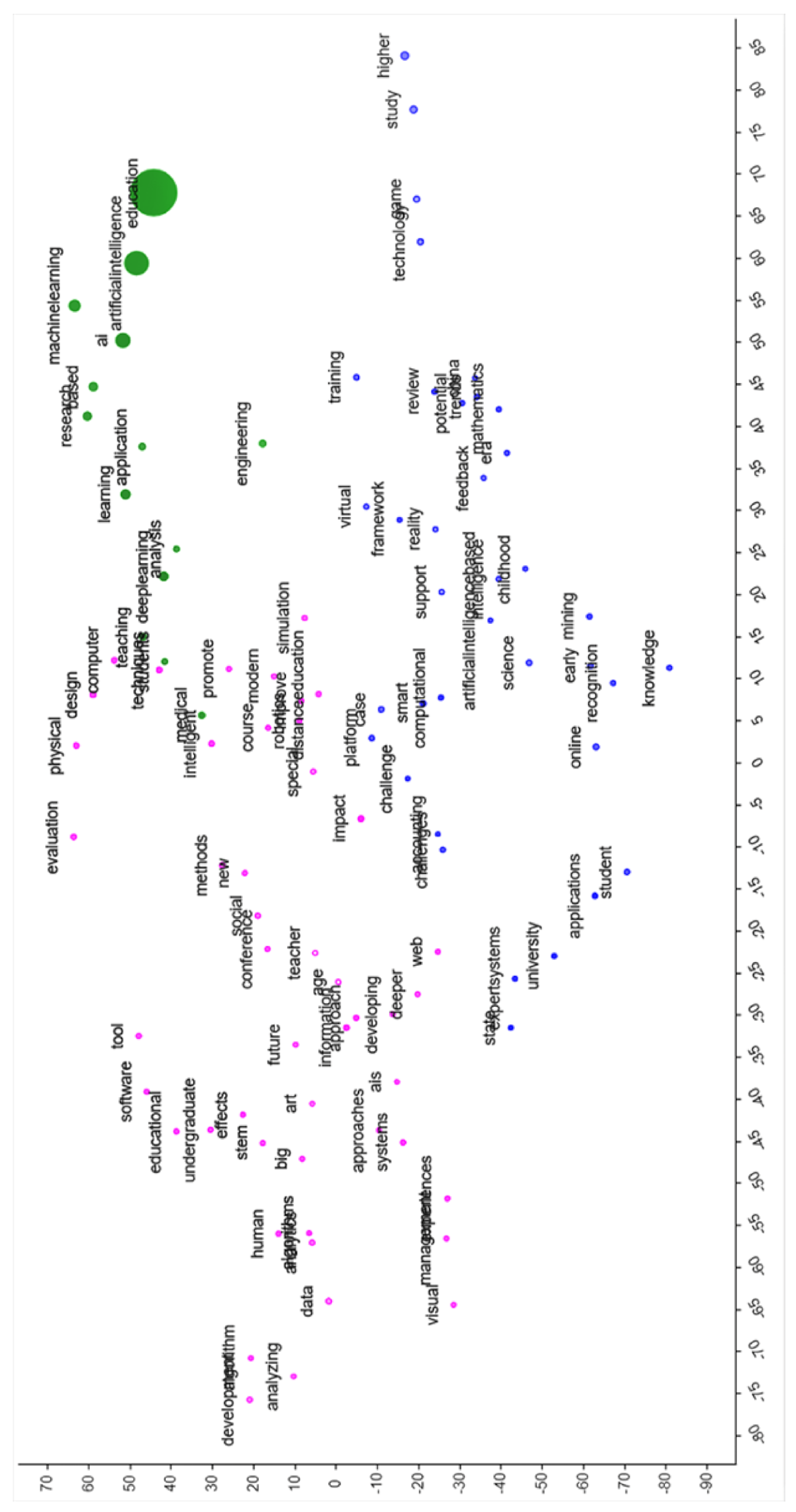
Appendix B
| Keywords | D * | BC ** | EC *** | PR **** | CC ***** |
|---|---|---|---|---|---|
| artificial intelligence | 259 | 11110.780 | 0.020 | 9.643 | 0.089 |
| education | 190 | 4591.324 | 0.016 | 6.904 | 0.120 |
| students | 186 | 3377.258 | 0.017 | 6.676 | 0.130 |
| teaching | 179 | 3351.602 | 0.016 | 6.444 | 0.133 |
| learning systems | 176 | 3070.155 | 0.016 | 6.308 | 0.137 |
| machine learning | 151 | 2155.189 | 0.015 | 5.341 | 0.160 |
| engineering education | 120 | 1317.008 | 0.012 | 4.351 | 0.188 |
| education computing | 114 | 1006.325 | 0.012 | 4.060 | 0.202 |
| e-learning | 92 | 624.772 | 0.010 | 3.300 | 0.236 |
| artificial intelligence | 82 | 614.130 | 0.008 | 2.977 | 0.220 |
| deep learning | 54 | 612.181 | 0.007 | 2.104 | 0.317 |
| computer software | 21 | 577.027 | 0.003 | 1.039 | 0.448 |
| computer aided instruction | 87 | 542.535 | 0.009 | 3.136 | 0.242 |
| curricula | 80 | 485.382 | 0.009 | 2.922 | 0.255 |
| big data | 67 | 412.517 | 0.008 | 2.450 | 0.275 |
| higher education | 59 | 336.804 | 0.007 | 2.190 | 0.296 |
| project-based learning | 7 | 332.583 | 0.001 | 0.565 | 0.524 |
| expert systems | 36 | 304.684 | 0.005 | 1.441 | 0.460 |
| artificial intelligence | 3 | 289.810 | 0.000 | 0.571 | 0.000 |
| learning algorithm | 66 | 266.359 | 0.008 | 2.396 | 0.332 |
| state of the art | 17 | 222.444 | 0.003 | 0.798 | 0.625 |
| neural networks | 59 | 215.027 | 0.008 | 2.138 | 0.338 |
| educational technology | 54 | 180.560 | 0.007 | 1.966 | 0.375 |
| human | 52 | 173.331 | 0.005 | 1.934 | 0.385 |
| data mining | 57 | 154.360 | 0.008 | 2.033 | 0.390 |
| virtual reality | 44 | 152.602 | 0.005 | 1.669 | 0.345 |
| artificial intelligence technology | 44 | 145.773 | 0.005 | 1.649 | 0.341 |
| intelligent tutoring system | 53 | 141.607 | 0.006 | 1.917 | 0.347 |
| technology | 41 | 130.582 | 0.005 | 1.557 | 0.380 |
| decision trees | 53 | 127.093 | 0.007 | 1.897 | 0.407 |
| artificial intelligence in education | 40 | 125.004 | 0.005 | 1.557 | 0.347 |
Appendix C

References
- Turing, A.M. Computing machinery and intelligence-AM Turing. Mind 1950, 59, 433–450. [Google Scholar] [CrossRef]
- Anyoha, R. Can Machines Think. Science in the News, Special Edition: Artificial Intelligence, Summer. 2017. Available online: http://sitn.hms.harvard.edu/flash/2017/history-artificial-intelligence/ (accessed on 9 January 2021).
- Etzioni, O.; Banko, M.; Cafarella, M.J. Machine Reading. AAAI. 2006, Volume 6, pp. 1517–1519. Available online: https://www.aaai.org/Papers/AAAI/2006/AAAI06-239.pdf (accessed on 9 January 2021).
- Hurley, R. Data Science: A Comprehensive Guide to Data Science, Data Analytics, Data Mining, Artificial Intelligence, Machine Learning, and Big Data. Independently Published; 2019; ISBN 978-1704636030. [Google Scholar]
- Hinton, G.E. Learning multiple layers of representation. Trends Cogn. Sci. 2007, 11, 428–434. [Google Scholar] [CrossRef]
- McGuire, B.; Huang, T.; Smith, C.; Yang, G. The History of Artificial Intelligence History of Computing CSEP, 5.9.0.A; University of Washington: Seattle, WA, USA, 2006. [Google Scholar]
- Press, G. A Very Short History of Artificial Intelligence (AI). 2016. Available online: https://www.forbes.com/sites/gilpress/2016/12/30/a-very-short-history-of-artificial-intelligence-ai/ (accessed on 10 January 2021).
- Chen, X.W.; Lin, X. Big data deep learning: Challenges and perspectives. IEEE Access 2014, 2, 514–525. [Google Scholar] [CrossRef]
- LeCun, Y.; Bengio, Y.; Hinton, G. Deep learning. Nature 2015, 521, 436. [Google Scholar] [CrossRef]
- Greenspan, H.; van Ginneken, B.; Summers, R.M. Guest editorial deep learning in medical imaging: Overview and future promise of an exciting new technique. IEEE Trans. Med Imaging 2016, 35, 1153–1159. [Google Scholar] [CrossRef]
- Copeland, M. What’s the Difference between Artificial Intelligence, Machine Learning, and Deep Learning? 2016. Available online: https://blogs.nvidia.com/blog/2016/07/29/whats-difference-artificial-intelligence-machine-learning-deep-learning-ai/ (accessed on 10 January 2021).
- Roll, I.; Wylie, R. Evolution and revolution in artificial intelligence in education. Int. J. Artif. Intell. Educ. 2016, 26, 582–599. [Google Scholar] [CrossRef]
- Koçoğlu, F.Ö.; Emre, İ.E.; Erol, Ç.S. Observation of Success Status of Employees in E-Learning Courses in Organizations with Data Mining. Int. J. E-Adopt. 2017, 9, 38–49. [Google Scholar] [CrossRef]
- Baneres, D.; Rodríguez-Gonzalez, M.E.; Serra, M. An early feedback prediction system for learners at-risk within a first-year higher education course. IEEE Trans. Learn. Technol. 2019, 12, 249–263. [Google Scholar] [CrossRef]
- Minaei-Bidgoli, B.; Kashy, D.A.; Kortemeyer, G.; Punch, W.F. Predicting student performance: An application of data mining methods with an educational web-based system. In Proceedings of the 33rd Annual Frontiers in Education Conference, Westminster, CO, USA, 5–8 November 2003. [Google Scholar]
- Al-Radaideh, Q.A.; Al-Shawakfa, E.M.; Al-Najjar, M.I. Mining student data using decision trees. In Proceedings International Arab Conference on Information Technology (ACIT’2006); Yarmouk University: Irbid, Jordan, 2006. [Google Scholar]
- Baradwaj, B.K.; Pal, S. Mining educational data to analyze students’ performance. Int. J. Adv. Comput. Sci. Appl. 2011, 2, 63–69. [Google Scholar] [CrossRef]
- Kavitha, P.; Moorthy, B.K.; Sudharshan, P.S.; Aarthi, T. Mapping artificial intelligence and education. In 2018 International Conference on Communication, Computing and Internet of Things (IC3IoT); IEEE: Piscataway, NJ, USA, 2018; pp. 165–168. [Google Scholar] [CrossRef]
- Kokku, R.; Sundararajan, S.; Dey, P.; Sindhgatta, R.; Nitta, S.; Sengupta, B. Augmenting Classrooms with AI for Personalized Education. Proceedings of 2018 IEEE International Conference on Acoustics, Speech and Signal Processing (ICASSP); IEEE: Piscataway, NJ, USA, 2018; pp. 6976–6980. [Google Scholar] [CrossRef]
- Vinuesa, R.; Azizpour, H.; Leite, I.; Balaam, M.; Dignum, V.; Domisch, S.; Nerini, F.F. The role of artificial intelligence in achieving the Sustainable Development Goals. Nat. Commun. 2020, 11, 1–10. [Google Scholar] [CrossRef]
- UN. Take Action for the Sustainable Development Goals. 2020. Available online: https://www.un.org/sustainabledevelopment/sustainable-development-goals/ (accessed on 10 January 2021).
- UNESCO. Futures of Education: Learning to Become. 2020. Available online: https://www.un.org/sustainabledevelopment/sustainable-development-goals/ (accessed on 10 January 2021).
- Kay, J. AI and education: Grand challenges. IEEE Intell. Syst. 2012, 27, 66–69. [Google Scholar] [CrossRef]
- Lin, P.H.; Wooders, A.; Wang, J.T.Y.; Yuan, W.M. Artificial intelligence, the missing piece of online education? IEEE Eng. Manag. Rev. 2018, 46, 25–28. [Google Scholar] [CrossRef]
- McCardle, J.R. The challenge of integrating ai & smart technology in design education. Int. J. Technol. Des. Educ. 2002, 12, 59–76. [Google Scholar] [CrossRef]
- Popenici, S.A.; Kerr, S. Exploring the impact of artificial intelligence on teaching and learning in higher education. Res. Pract. Technol. Enhanc. Learn. 2017, 12, 22. [Google Scholar] [CrossRef]
- Sharma, R.C.; Kawachi, P.; Bozkurt, A. The landscape of artificial intelligence in open, online and distance education: Promises and concerns. Asian J. Distance Educ. 2019, 14, 1–2. [Google Scholar]
- Educause. Educause Horizon Report 2019: Higher Education Edition. 2019. Available online: https://library.educause.edu/-/media/files/library/2019/4/2019horizonreport.pdf (accessed on 10 January 2021).
- Yang, S.; Tian, H.; Sun, L.; Yu, X. From One-size-fits-all Teaching to Adaptive Learning: The Crisis and Solution of Education in The Era of AI. J. Phys. 2019, 1237, 042039. [Google Scholar] [CrossRef]
- Florea, A.M.; Radu, S. Artificial Intelligence and Education. In 2019 22nd International Conference on Control Systems and Computer Science (CSCS); IEEE: Piscataway, NJ, USA, 2019; pp. 381–382. [Google Scholar] [CrossRef]
- Hinojo-Lucena, F.J.; Aznar-Díaz, I.; Cáceres-Reche, M.P.; Romero-Rodríguez, J.M. Artificial intelligence in higher education: A bibliometric study on its impact in the scientific literature. Educ. Sci. 2019, 9, 51. [Google Scholar] [CrossRef]
- Yang, J.; Zhang, B. Artificial intelligence in intelligent tutoring robots: A systematic review and design guidelines. Appl. Sci. 2019, 9, 2078. [Google Scholar] [CrossRef]
- Zawacki-Richter, O.; Marín, V.I.; Bond, M.; Gouverneur, F. Systematic review of research on artificial intelligence applications in higher education–where are the educators? Int. J. Educ. Technol. High. Educ. 2019, 16. [Google Scholar] [CrossRef]
- Goksel, N.; Bozkurt, A. Artificial Intelligence in Education: Current Insights and Future Perspectives. In Handbook of Research on Learning in the Age of Transhumanism Hershey; Sisman-Ugur, S., Kurubacak, G., Eds.; IGI Global: Hershey, PA, USA, 2019; pp. 224–236. [Google Scholar] [CrossRef]
- Petticrew, M.; Roberts, H. Systematic Reviews in the Social Sciences: A Practical Guide; John Wiley & Sons: Hoboken, NJ, USA, 2008. [Google Scholar]
- Hansen, D.; Shneiderman, B.; Smith, M.A. Analyzing Social Media Networks with NodeXL: Insights from a Connected World; Morgan Kaufmann: Amsterdam, The Netherlands, 2010. [Google Scholar]
- Weiss, S.M.; Indurkhya, N.; Zhang, T.; Damerau, F. Text Mining: Predictive Methods for Analyzing Unstructured Information; Springer Science & Business Media: Berlin/Heidelberg, Germany, 2010. [Google Scholar]
- Foster, R.L. Addressing epistemologic and practical issues in multimethod research: A procedure for conceptual triangulation. Adv. Nurs. Sci. 1997, 20, pp. 1–12. Available online: https://journals.lww.com/advancesinnursingscience/pages/default.aspx (accessed on 10 January 2021).
- Rogers, E.M. Diffusion of Innovations; Free Press: New York, NY, USA, 2003. [Google Scholar]
- Sheldon, N. China Has Started a Grand Experiment in AI Education. It Could Reshape How the World Learns. MIT Technology Review. 2019. Available online: https://www.technologyreview.com/s/614057/china-squirrel-has-started-a-grand-experiment-in-ai-education-it-could-reshape-how-the/ (accessed on 10 January 2021).
- Wang, Y.; Hong, S.; Tai, C. China’s Efforts to Lead the Way in AI Start in Its Classrooms. Wall Street J. 2019. Available online: https://www.wsj.com/articles/chinas-efforts-to-lead-the-way-in-ai-start-in-its-classrooms-11571958181 (accessed on 10 January 2021).
- Crofts, K.; Bisman, J. Interrogating accountability: An illustration of the use of Leximancer software for qualitative data analysis. Qual. Res. Account. Manag. 2010, 7, 180–207. [Google Scholar] [CrossRef]
- Bajaj, R.; Sharma, V. Smart Education with artificial intelligence based determination of learning styles. Procedia Comput. Sci. 2018, 132, 834–842. [Google Scholar] [CrossRef]
- Ciolacu, M.; Tehrani, A.F.; Binder, L.; Svasta, P.M. Education 4.0-Artificial Intelligence Assisted Higher Education: Early recognition System with Machine Learning to support Students’ Success. In 2018 IEEE 24th International Symposium for Design and Technology in Electronic Packaging (SIITME); IEEE: Piscataway, NJ, USA, 2018; pp. 23–30. [Google Scholar] [CrossRef]
- Almohammadi, A.; Hagras, H.; Alghazzawi, D.; Aldabbagh, G. A survey of artificial intelligence techniques employed for adaptive educational systems within e-learning platforms. J. Artif. Intell. Soft Comput. Res. 2017, 7, 47–64. [Google Scholar]
- Murray, R.; Shea, M.; Shea, B.; Harlin, R. Issues in education: Avoiding the one-size-fits-all curriculum: Textsets, inquiry, and differentiating instruction. Child. Educ. 2004, 81, 33–35. [Google Scholar] [CrossRef]
- Salloum, S.A.; Alshurideh, M.; Elnagar, A.; Shaalan, K. Mining in Educational Data: Review and Future Directions. Proceedings of Advances in Intelligent Systems and Computing; Springer International Publishing: Cham, Switzerland, 2020; pp. 92–102. [Google Scholar] [CrossRef]
- Hernández-Blanco, A.; Herrera-Flores, B.; Tomás, D.; Navarro-Colorado, B. A systematic review of deep learning approaches to educational data mining. Complexity 2019, 2019, 1–22. [Google Scholar] [CrossRef]
- Aldowah, H.; Al-Samarraie, H.; Fauzy, W.M. Educational data mining and learning analytics for 21st century higher education: A review and synthesis. Telemat. Inform. 2019, 37, 13–49. [Google Scholar] [CrossRef]
- Papamitsiou, Z.; Economides, A. Learning Analytics and Educational Data Mining in Practice: A Systematic Literature Review of Empirical Evidence. Educ. Technol. Soc. 2014, 17, pp. 49–64. Available online: https://www.jstor.org/stable/jeductechsoci.17.4.49 (accessed on 10 January 2021).
- Ray, S.; Saeed, M. Applications of educational data mining and learning analytics tools in handling big data in higher education. In Applications of Big Data Analytics; Springer: Cham, Switzerland, 2018; pp. 135–160. [Google Scholar]
- Holstein, K.; Aleven, V.; Rummel, N. A Conceptual Framework for Human–AI Hybrid Adaptivity in Education. In International Conference on Artificial Intelligence in Education; Springer: Cham, Switzerland, 2020; pp. 240–254. [Google Scholar] [CrossRef]
- Riedl, M.O. Human-centered artificial intelligence and machine learning. Hum. Behav. Emerg. Technol. 2019, 1, 33–36. [Google Scholar] [CrossRef]
- Sundar, S.S. Rise of Machine Agency: A Framework for Studying the Psychology of Human–AI Interaction (HAII). J. Comput. -Mediat. Commun. 2020, 25, 74–88. [Google Scholar] [CrossRef]
- Amershi, S.; Weld, D.; Vorvoreanu, M.; Fourney, A.; Nushi, B.; Collisson, P.; Teevan, J. Guidelines for human-AI interaction. In Proceedings of the 2019 CHI Conference on Human Factors in Computing Systems, Scotland, UK, 04–09 May 2019; pp. 1–13. [Google Scholar] [CrossRef]
- Hois, J.; Theofanou-Fuelbier, D.; Junk, A.J. How to Achieve Explainability and Transparency in Human AI Interaction. In International Conference on Human-Computer Interaction; Springer: Cham, Switzerland, 2019; pp. 177–183. [Google Scholar]
- Malik, M. Meta-analysis and review of the use of Artificial Intelligence and Learning Analytics within Engineering Education at University level. In 5th Symposium of the UK & IE Engineering Education Network; Royal Academy of Engineering: London, UK, 2018; pp. 38–41. [Google Scholar]
- Rienties, B.; Køhler Simonsen, H.; Herodotou, C. Defining the boundaries between Artificial Intelligence in Education, Computer-Supported Collaborative Learning, Educational Data Mining, and Learning Analytics: A need for coherence. Front. Educ. 2020, 2020. [Google Scholar] [CrossRef]
- Pence, H.E. Artificial Intelligence in Higher Education: New Wine in Old Wineskins? J. Educ. Technol. Syst. 2019, 48, 5–13. [Google Scholar] [CrossRef]
- Rubens, N.; Kaplan, D.; Okamoto, T. E-Learning 3.0: Anyone, anywhere, anytime, and AI. In International Conference on Web-based Learning; Springer: Berlin/Heidelberg, Germany, 2012; pp. 171–180. [Google Scholar]
- Bates, T.; Cobo, C.; Mariño, O.; Wheeler, S. Can artificial intelligence transform higher education? Int. J. Educ. Technol. High. Educ. 2020, 17. [Google Scholar] [CrossRef]
- Nye, B.D. The End of the World as We Know It: Transitioning AIED into a Service-Oriented Ecosystem. Int. J. Artif. Intell. Educ. 2016, 26, 756–770. [Google Scholar] [CrossRef]
- Mouta, A.; Torrecilla, E.; Pinto, A. Blending machines, learning, and ethics. In Proceedings of the Seventh International Conference on Technological Ecosystems for Enhancing Multiculturality (TEEM 2019), León, Spain, 16–18 October 2019; ACM: New York, NY, USA, 2019. [Google Scholar] [CrossRef]
- Bozkurt, A.; Sharma, R.C. Education in normal, new normal, and next normal: Observations from the past, insights from the present and projections for the future. Asian J. Distance Educ. 2020, 15, i–x. [Google Scholar] [CrossRef]
- Murphy, R.F. Artificial Intelligence Applications to Support K–1 2 Teachers and Teaching; RAND Corporation: Santa Monica, CA, USA, 2019. [Google Scholar] [CrossRef]
- Gitelman, L.; Jackson, V. Introduction. In “Raw Data” Is an Oxymoron; Gitelman, L., Ed.; The MIT Press: Cambridge, MA; London, UK, 2013; pp. 1–14. [Google Scholar] [CrossRef]
- Nichols, M.; Holmes, W. Don’t do evil: Implementing artificial intelligence in universities. Towards Pers. Guid. Support Learn. 2018, 109, 110–118. [Google Scholar]
- Wright, D.; Finn, R.; Gellert, R.; Gutwirth, S.; Schütz, P.; Friedewald, M.; Venier, S.; Mordini, E. Ethical dilemmas scenarios and emerging technologies. Technol. Forecast. Soc. Chang. 2014, 87, 325–333. [Google Scholar] [CrossRef]
- Brey, P. Ethics of Emerging Technologies. In Methods for the Ethics of Technology; Hansson, S.O., Ed.; Rowman and Littlefield International: Lanham, MD, USA, 2017. [Google Scholar]
- HLEG. Ethics Guidelines for Trustworthy AI. 2019. Available online: https://ec.europa.eu/digital-single-market/en/news/ethics-guidelines-trustworthy-ai (accessed on 23 May 2020).

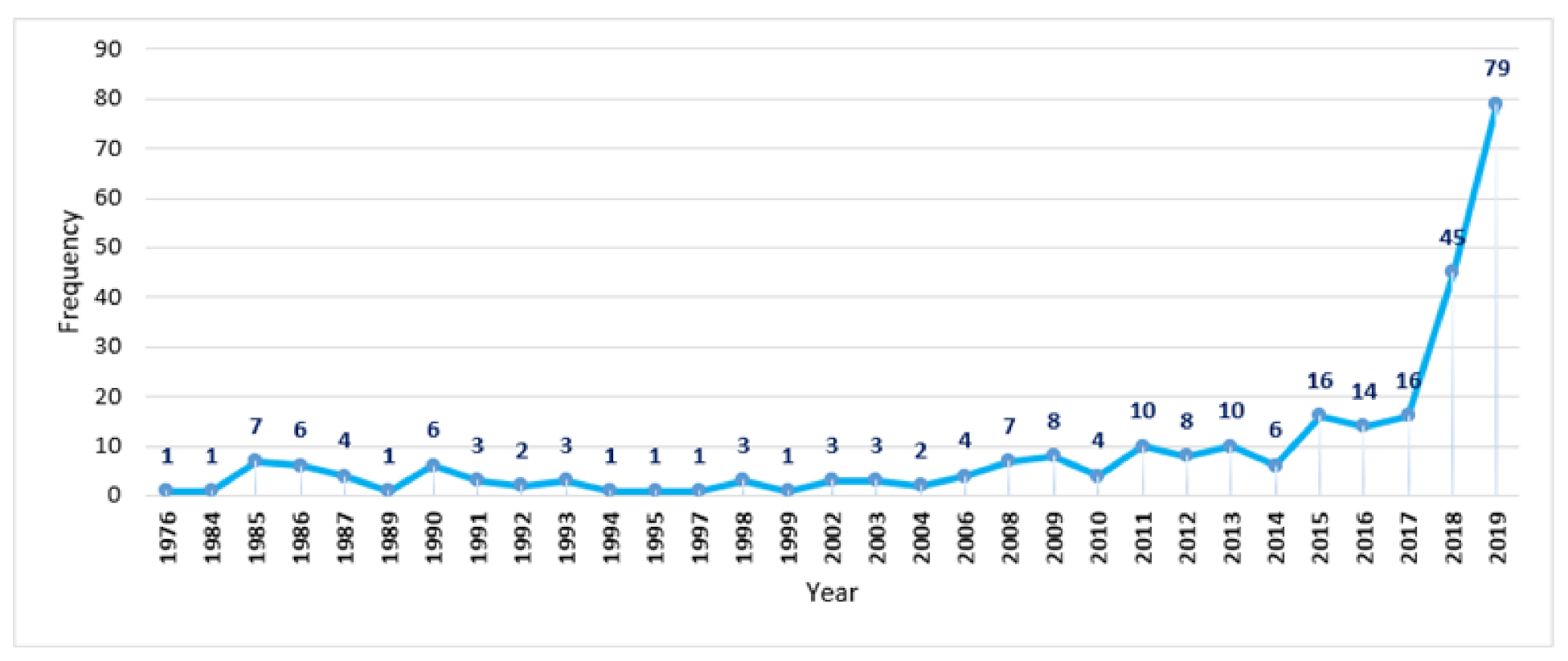
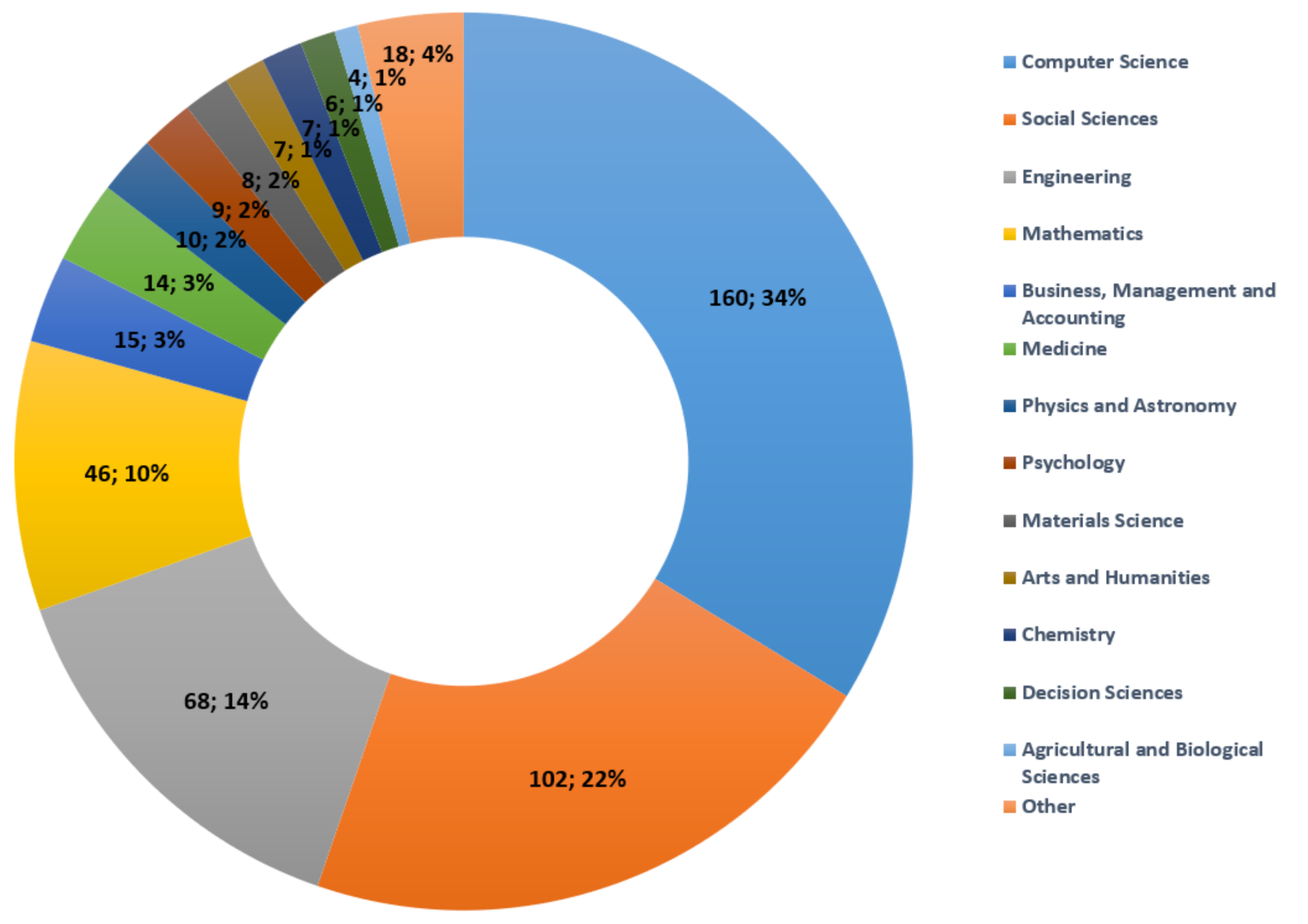
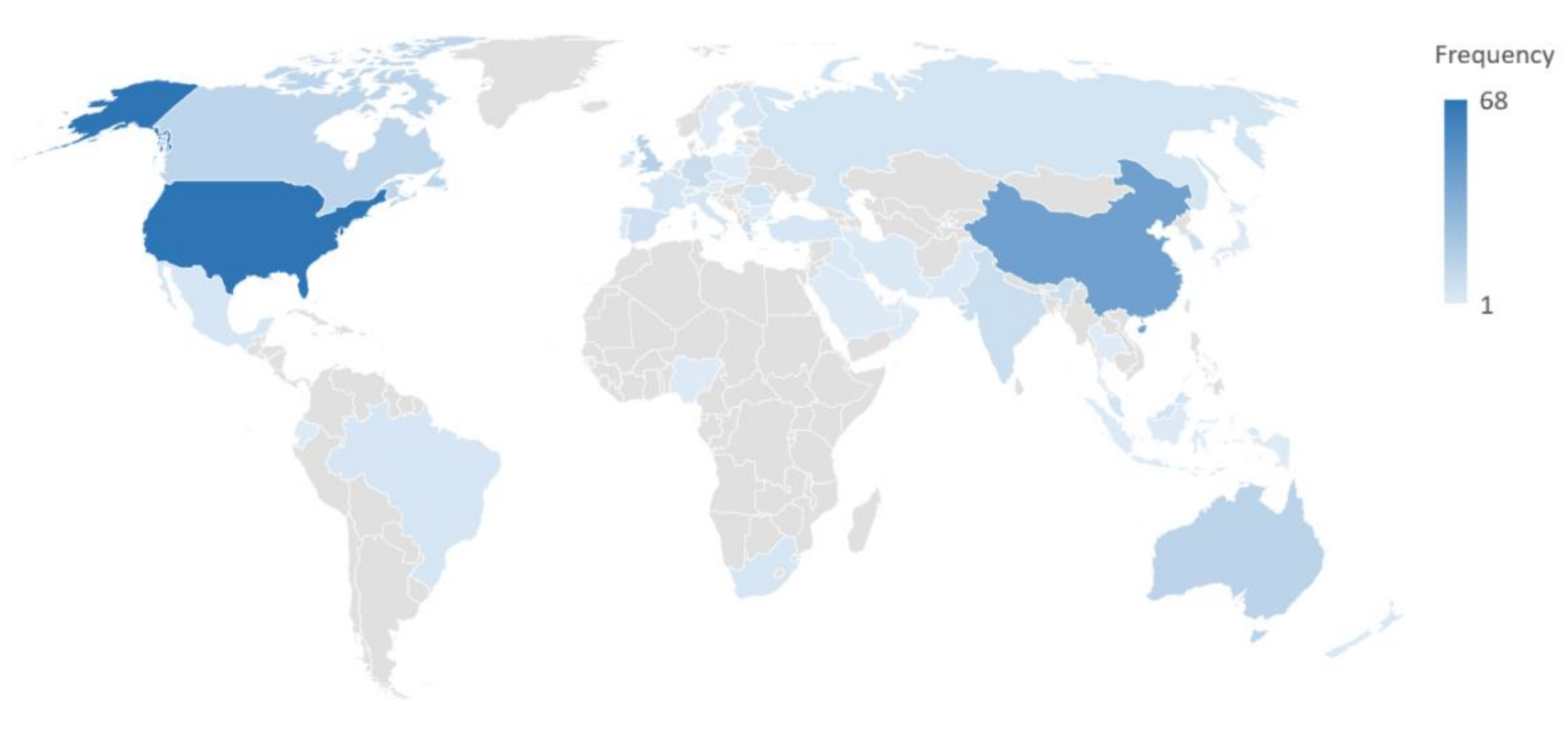
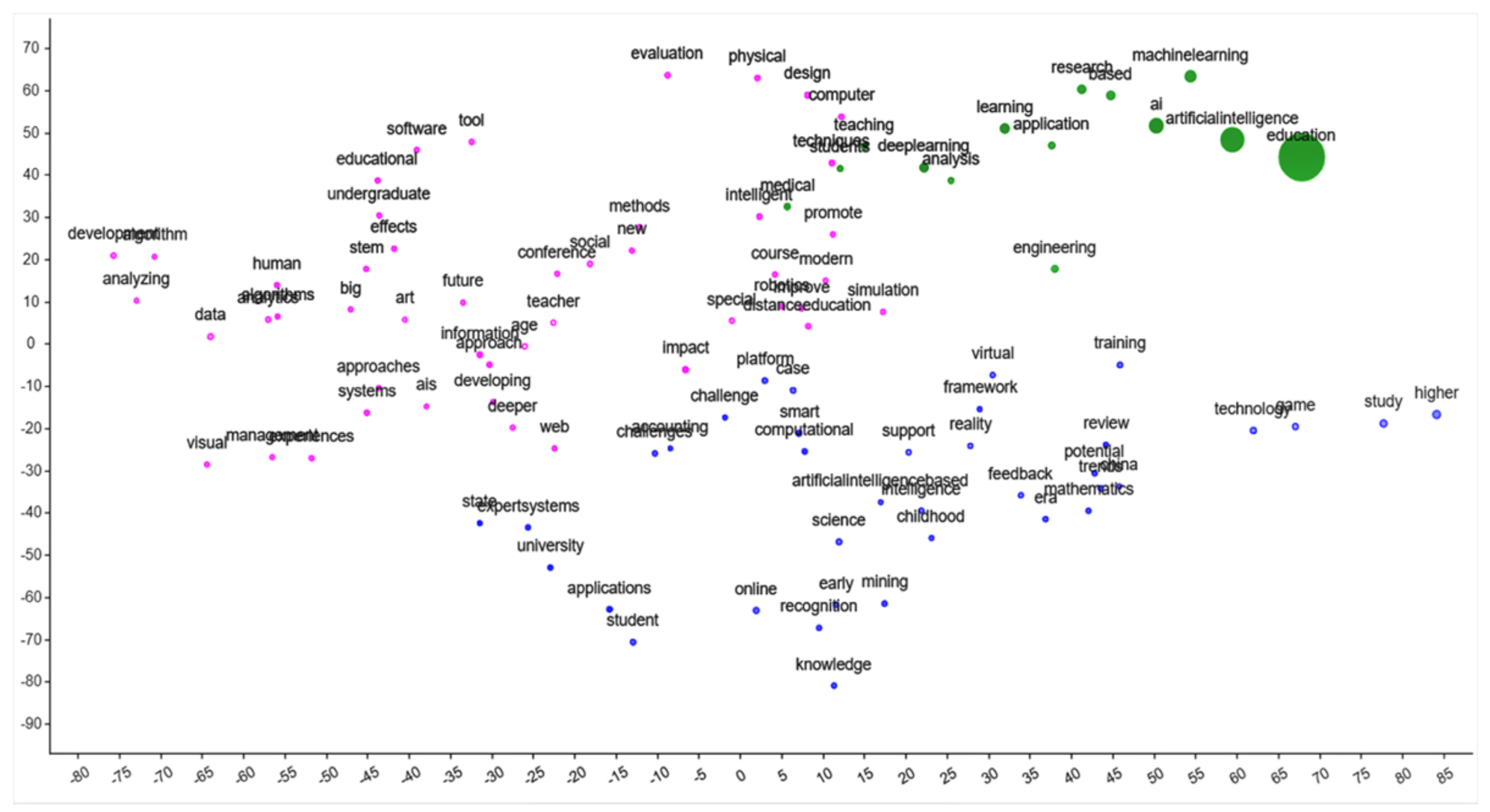
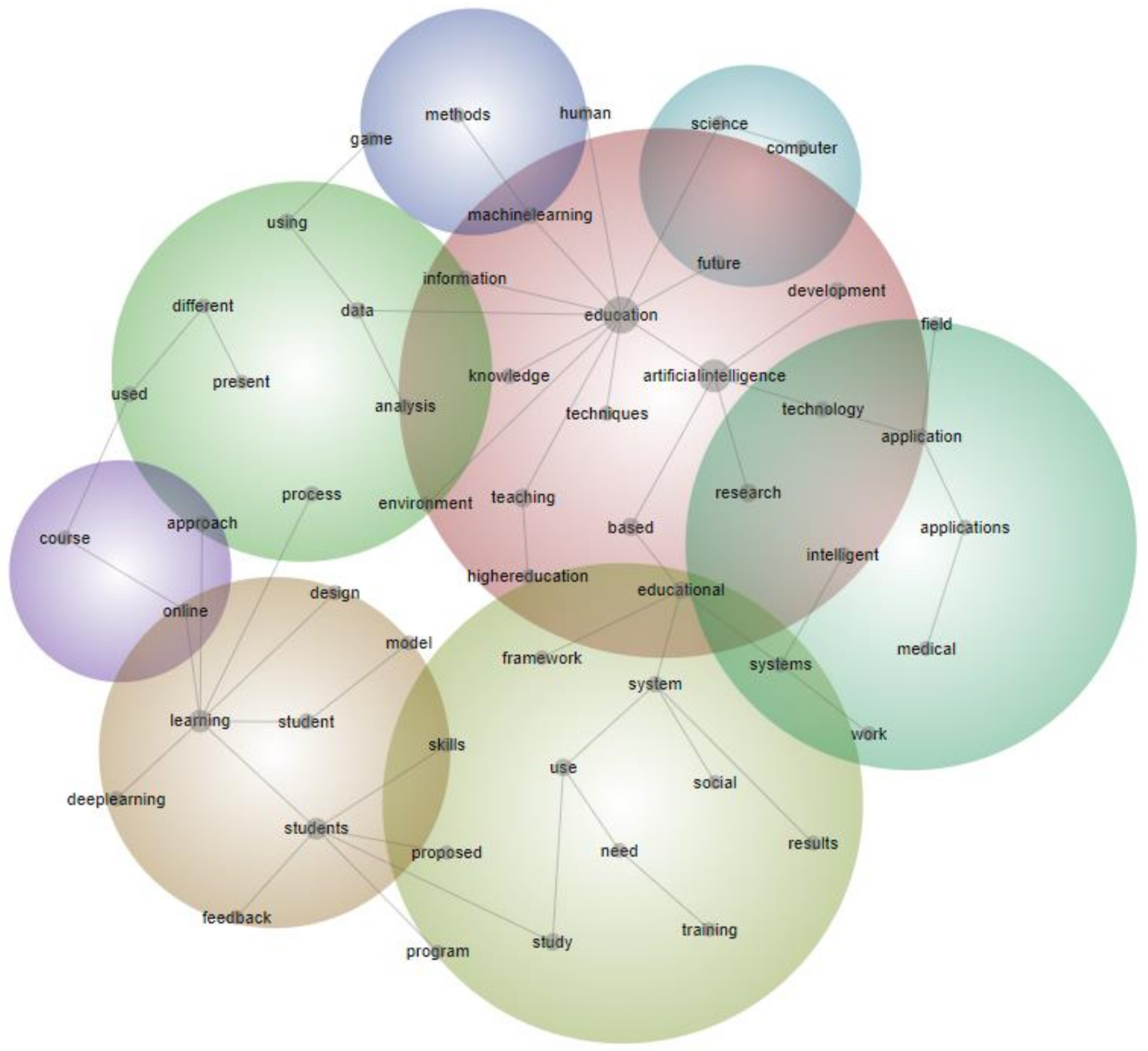

Publisher’s Note: MDPI stays neutral with regard to jurisdictional claims in published maps and institutional affiliations. |
© 2021 by the authors. Licensee MDPI, Basel, Switzerland. This article is an open access article distributed under the terms and conditions of the Creative Commons Attribution (CC BY) license (http://creativecommons.org/licenses/by/4.0/).
Share and Cite
Bozkurt, A.; Karadeniz, A.; Baneres, D.; Guerrero-Roldán, A.E.; Rodríguez, M.E. Artificial Intelligence and Reflections from Educational Landscape: A Review of AI Studies in Half a Century. Sustainability 2021, 13, 800. https://doi.org/10.3390/su13020800
Bozkurt A, Karadeniz A, Baneres D, Guerrero-Roldán AE, Rodríguez ME. Artificial Intelligence and Reflections from Educational Landscape: A Review of AI Studies in Half a Century. Sustainability. 2021; 13(2):800. https://doi.org/10.3390/su13020800
Chicago/Turabian StyleBozkurt, Aras, Abdulkadir Karadeniz, David Baneres, Ana Elena Guerrero-Roldán, and M. Elena Rodríguez. 2021. "Artificial Intelligence and Reflections from Educational Landscape: A Review of AI Studies in Half a Century" Sustainability 13, no. 2: 800. https://doi.org/10.3390/su13020800
APA StyleBozkurt, A., Karadeniz, A., Baneres, D., Guerrero-Roldán, A. E., & Rodríguez, M. E. (2021). Artificial Intelligence and Reflections from Educational Landscape: A Review of AI Studies in Half a Century. Sustainability, 13(2), 800. https://doi.org/10.3390/su13020800







